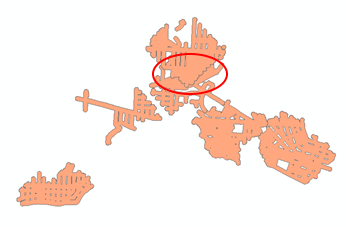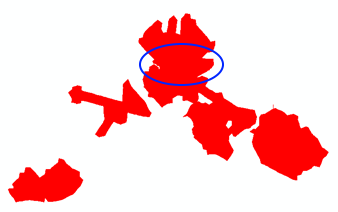- Home
- :
- All Communities
- :
- Products
- :
- Data Management
- :
- Data Management Questions
- :
- I need to convert a network buffer polygon (that h...
- Subscribe to RSS Feed
- Mark Topic as New
- Mark Topic as Read
- Float this Topic for Current User
- Bookmark
- Subscribe
- Mute
- Printer Friendly Page
I need to convert a network buffer polygon (that has gaps) into a solid polygon that extends to the maximum edge?
- Mark as New
- Bookmark
- Subscribe
- Mute
- Subscribe to RSS Feed
- Permalink
I need to convert a network buffer polygon (that has gaps) into a solid polygon that extends to the maximum edge?
For example, from this...

to this:

- Mark as New
- Bookmark
- Subscribe
- Mute
- Subscribe to RSS Feed
- Permalink
Thank you everyone, what a great online community!
- Mark as New
- Bookmark
- Subscribe
- Mute
- Subscribe to RSS Feed
- Permalink
Hi Everyone, I tried those techniques and while the union worked, when I dissolved the polygons, it merged into other separate files. Each polygon is a walkability buffer network, and I need to keep them separate. I want to create a "solid" buffer so that I can analyze other factors such as the amount of PT stops within the buffer. I have eliminate polygon which I also tried and didn't seem to work. Will the python code troubleshoot this do you think?
- Mark as New
- Bookmark
- Subscribe
- Mute
- Subscribe to RSS Feed
- Permalink
I have several questions, but it would probably be easier if you could attach a sample featureclass of what you have. I can run the code and send you back the result, and then it will probably be easier to discuss what needs to be changed and it can be changed into a tool so you can run it easily.
One of the things that is not entirely clear to me is that it seems you have overlap in the input polygons:

In the result you posted it seems to be merged into a "single" features:

Is that what you want?
- Mark as New
- Bookmark
- Subscribe
- Mute
- Subscribe to RSS Feed
- Permalink
Xander, which is why I suggested the buffer out with dissolve, buffer in. And if you look at the very top, a piece that wasn't initially connected is in the 'desired' output. Your code works, but it doesn't give the level of generalization that is implied... I guess it is the choice between the various options that have been proposed.
- Mark as New
- Bookmark
- Subscribe
- Mute
- Subscribe to RSS Feed
- Permalink
The problem with a negative buffer following a positive buffer, is that the geometry will change. Not sure if that will yield the desired result. Best option IMHO is to have a look at an actual featureclass and get a better understanding of the situation.
- Mark as New
- Bookmark
- Subscribe
- Mute
- Subscribe to RSS Feed
- Permalink
true... but the area above your blue oval in the second image is what got me thinking about it, the geometry seems quite generalized in spots... but that type of generalization could be readily done after the holes are removed, rather than relying on buffering to close them.
- « Previous
-
- 1
- 2
- Next »
- « Previous
-
- 1
- 2
- Next »